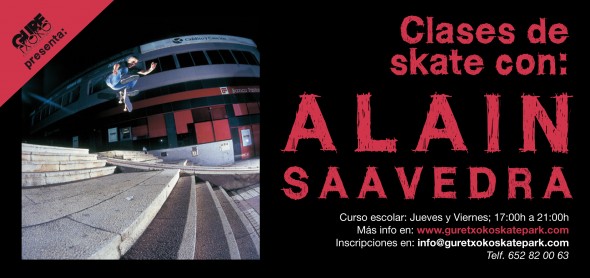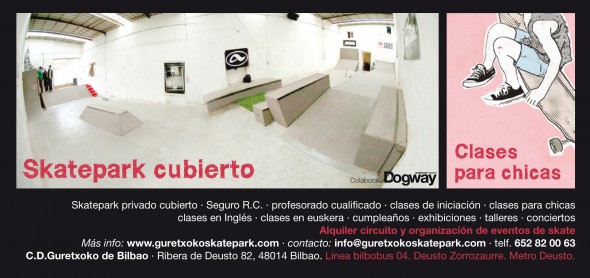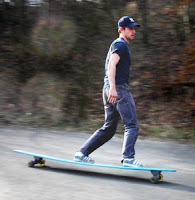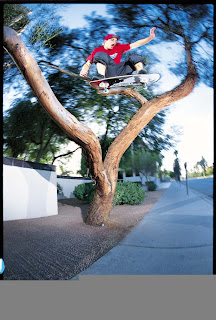Bob Burnquist jumps off a ramp and grinds on a rail into the grand canyon -basejumping
http://www.youtube.com/watch?v=3DQLDLLBzok
Skate and Adrenaline
The perfect blog for the people who loves skating and feeling the adrenaline doing dangerous tricks.Here you have some videos, photos and descripcions of famous skaters and tricks.
miércoles, 20 de octubre de 2010
Top 6 reasons to skateboard!!
http://www.youtube.com/watch?v=Ogwowz2BkGE&feature=related
1. Skateboard to Try Something New
If you haven't given skateboarding a shot, and you are looking for something to challenge yourself with, then skateboarding is a perfect choice. It's unique, and while skateboarding has grown a ton in popularity over the last few years, there are still piles of people out there who haven't tried it. Skateboarding will challenge you in new ways and teach you a new skill set. Trying new things and gaining new experiences is what keeps your brain alive and active, which in turn gives you new insights into the world and makes you a better, more interesting person!2. Skateboard for Fitness
This might seem weird at first, because of the dangers that go along with skateboarding. It's true, sometimes you will fall and scrape your knee or elbow. But, skateboarding trains your body in unique ways. A huge part of skateboarding is balance, so your core will gain strength as you skate. Plus, your legs will get a good workout as well. Skateboarding is also very aerobic, and you can easily work up a sweat while skating. It's pretty easy to loose weight when you are out pumping your board around all afternoon. If you really dig into skateboarding, you'll end up lean and tough.3. Skateboard to Make Friends
This is true no matter your age. If you are a teenager, then there should be groups of skaters at school, and if you choose to skate, you should have several groups of instant friends if you want. Now, teenagers can be weird and mean, so who knows how that will work out, but picking a hobby other than watching TV on your couch will always make it easier to make friends. You'll be more interesting. This works for adults, too. Plus, it's easy to run into people at skateparks and make friends, or you can check at your local skate shop for local groups and clubs.4. Skateboarding Teaches Perseverance
Sometimes you learn a trick one day, and then the next day you just can't land it. Sometimes you're doing great, and suddenly you find yourself smashing into the pavement and it hurts. Sometimes you practice the same trick for a month - or several months - and you just can't seem to get it. But you stick with it. You keep trying. You lean the value of staying with something, even when it's not easy, even when people make fun of you or don't understand you, and even when you have no one pushing you but yourself. Life is tough, and learning to push through because the payoff is worth it will help in every way.5. Skateboard to Build Confidence
When you've been practicing a trick for a long, long time, and you finally get it, you realize something. You realize that you can do something that only a small handful of people on the planet can even do. You learn that if you try hard, you can defy gravity. So you move on to a harder trick, and then a harder one yet. You start to learn that you can skate, no matter what other people say. Sometimes this gets tied into rebellion and breaking the law, but it's also building confidence, which is key to success. It sounds cheesy, but believing in yourself and understanding how powerful you really are is important!6. Skateboard for Fun!
All of these other reasons are good, and if you add them up by themselves you can see that there are plenty of reasons to skateboard. But, the great news is that skateboarding is also fun! And not fun like playing a video game is fun - skateboarding is that deep kind of fun that gets down into your gut. Maybe it's because of all of these other reasons chipping in, plus learning and landing a new trick, feeling the burn and the wind as you fly down the sidewalk, the click-clack sounds and crack of the tail as you olly, the pull of gravity and you bend your knees and push up a ramp or around a corner - skating rocks!Skateboard.what is it?
A skateboard is typically a specially designed plywood board combined with a poly urathane coating used for making smoother grinds and stronger durability, used primarily for the activity of skateboarding.
It appears the first skateboards to reach public notice came out of the surfing craze of the early 1960's, probably just wooden boards with roller-skate wheels attached. The surfing group Jan and Dean even had a minor hit called "Sidewalk Surfing" in 1964. The modern skateboard originated in California in the 1970s with the advent of polyurethane wheels. In time, it became a pastime for surfers when the waves were lax. By the mid 1980s they were mass produced and sold throughout the United States.
A skateboard is propelled by pushing with one foot while the other remains on the board, or by pumping one's legs in structures such as a pool or half pipe. A skateboard can also be used by simply standing on the deck while on a downward slope and allowing gravity to propel the board and rider. If you ride with your right foot forward, you ride "goofy"; if you ride with your left foot forward, you ride regular.
Recently, electric skateboards have also appeared. These no longer require the propelling of the skateboard by means of the feet; rather a electric engine propells the board, fed by an electric battery.
There is no governing body that declares any regulations on what constitutes a skateboard or the parts from which it is assembled. Historically, the skateboard has conformed both to contemporary trends and to the ever evolving array of stunts performed by riders/users, who require a certain functionality from the board. Of course, the board shape depends largely upon its desired function. Longboards are a type of skateboard with a longer wheelbase and larger, softer wheels.
ANATOMY OF AN SKATEBOARD
It appears the first skateboards to reach public notice came out of the surfing craze of the early 1960's, probably just wooden boards with roller-skate wheels attached. The surfing group Jan and Dean even had a minor hit called "Sidewalk Surfing" in 1964. The modern skateboard originated in California in the 1970s with the advent of polyurethane wheels. In time, it became a pastime for surfers when the waves were lax. By the mid 1980s they were mass produced and sold throughout the United States.
A skateboard is propelled by pushing with one foot while the other remains on the board, or by pumping one's legs in structures such as a pool or half pipe. A skateboard can also be used by simply standing on the deck while on a downward slope and allowing gravity to propel the board and rider. If you ride with your right foot forward, you ride "goofy"; if you ride with your left foot forward, you ride regular.
Recently, electric skateboards have also appeared. These no longer require the propelling of the skateboard by means of the feet; rather a electric engine propells the board, fed by an electric battery.
There is no governing body that declares any regulations on what constitutes a skateboard or the parts from which it is assembled. Historically, the skateboard has conformed both to contemporary trends and to the ever evolving array of stunts performed by riders/users, who require a certain functionality from the board. Of course, the board shape depends largely upon its desired function. Longboards are a type of skateboard with a longer wheelbase and larger, softer wheels.
ANATOMY OF AN SKATEBOARD
Now most skateboarders know their parts, but this section is geared towards new skaters and parents.
There are a few very important parts to getting your setup to work for you.

•DECK: This is the main component to making a skateboard, it is also the main product for this site. The deck is the wooden part of the skateboard, these are usually made from about seven peices of high quality wood glued and compressed together then cut to give the shape. A common skateboard deck is 7ply, or made from seven peices of wood. The parts where the board raise on the ends are called the nose and the tail. A good board has a nose that is a little bit larger in size than the tail, this is for better control of flip tricks.
•GRIPTAPE: The black sandpaper part on top of the deck. This allows the skater to 'stick' to the board when they are doing tricks. This is a very important part to skateboarding, without it the rider would slip off the surface of the deck if they attempted to do any kind of trick.
•TRUCK: The metal axle that attaches to the board. This piece holds the wheels on so a skater can actually skate. Trucks also allow the rider to turn and do certain grind tricks.
•WHEEL: A very important part of a skateboard, without wheels how do you plan on rolling?
•BEARINGS: Just like on a car the bearings allow the wheels to turn. If you are a parent buying parts to get your child a skateboard make sure you don't forget this because most un-informed parents do.
•HARDWARE: Another overlooked piece. The hardware is a set of 8 nuts and bolts which hold the trucks to the skateboard base. If there wasn't any hardware you wouldn't be able to do much other than stand on a piece of wood.
•RAISER: The little pads attached under the deck and before the trucks to give more space between the wood and the wheels. If your wheels are to large then they will rub against the deck which is very dangerous and is called "Wheel Bite". If the skater is going at a decent speed and they get wheel bite they will no doubt go flying forward. Although raisers sound important they are rarely used in street skating.
There are a few very important parts to getting your setup to work for you.

•DECK: This is the main component to making a skateboard, it is also the main product for this site. The deck is the wooden part of the skateboard, these are usually made from about seven peices of high quality wood glued and compressed together then cut to give the shape. A common skateboard deck is 7ply, or made from seven peices of wood. The parts where the board raise on the ends are called the nose and the tail. A good board has a nose that is a little bit larger in size than the tail, this is for better control of flip tricks.
•GRIPTAPE: The black sandpaper part on top of the deck. This allows the skater to 'stick' to the board when they are doing tricks. This is a very important part to skateboarding, without it the rider would slip off the surface of the deck if they attempted to do any kind of trick.
•TRUCK: The metal axle that attaches to the board. This piece holds the wheels on so a skater can actually skate. Trucks also allow the rider to turn and do certain grind tricks.
•WHEEL: A very important part of a skateboard, without wheels how do you plan on rolling?
•BEARINGS: Just like on a car the bearings allow the wheels to turn. If you are a parent buying parts to get your child a skateboard make sure you don't forget this because most un-informed parents do.
•HARDWARE: Another overlooked piece. The hardware is a set of 8 nuts and bolts which hold the trucks to the skateboard base. If there wasn't any hardware you wouldn't be able to do much other than stand on a piece of wood.
•RAISER: The little pads attached under the deck and before the trucks to give more space between the wood and the wheels. If your wheels are to large then they will rub against the deck which is very dangerous and is called "Wheel Bite". If the skater is going at a decent speed and they get wheel bite they will no doubt go flying forward. Although raisers sound important they are rarely used in street skating.

similarities to skateboards
LONGBOARDS
A longboard is a type of skateboard that is similar to a surfboard with wheels. They are commonly used for cruising, downhill racing, slalom racing, or transportation, rather than stunts. Fluent motions or tricks can be strung together, referred to as "dancing". Longboards can be shaped in various ways, depending on the type of riding for which the board is intended. Their greater weight and bulk makes them less suitable for many skateboarding tricks, but contributes to a fluid motion by providing more momentum. Longboarding is often compared to surfing on concrete, and the design allows big turns or quick short carves similar to a surfboard or snowboard.
Longboard equipment is very similar to standard skateboard equipment. Many longboarders wear gloves and a helmet, in addition to wrist, elbow, and knee protection. In the sliding and downhill disciplines, riders wear "slide gloves" which are a specialized glove made out of a strong material such as leather, and have "pucks" attached, which are usually made of delrin, ultra high molecular weight polyethylene (often shortened to UHMW), or corian. Polyethylene cutting boards are also sometimes cut into pucks and used, but they are less resistant to heat and will sometimes melt when used on rough pavement. A Slide is where the rider gets low enough to pull upwards on his board making the wheels lose tractions on the ground. there are many variations in which slides can be performed.[1]Most longboards measure between 90 and 150 cm (35.4-60 inches). Shorter boards may still be referred to as longboards when their main purpose is in line with that of longboarding. There are several different shapes of longboards, including pintails, flat nose riders, and boards shaped like a longer shortboard. Pintails permit looser trucks and larger diameter wheels better suited for carving or a "surfy" feel. Mid-length boards, 94-127 cm (37-50 inches) are the most versatile.
http://www.youtube.com/watch?v=3Uzlm-QwjxE
martes, 19 de octubre de 2010
skate classes in deusto
Clases de skate con Alain Saavedra en Guretxoko

Este Curso,todos los jueves y viernes, de 17:00h a 21:00h, Alain Saavedra estar dando las clases de skate, en Guretxoko, Estamos comenzando a concretar los grupos, que seran de maximo diez personas, primero completaremos la clase del viernes de 17:00 a 19:00, despues la del viernes de 19:00 a 21:00, y despues los grupos del jueves, en los mismos horarios.Las plazas limitadas!!!

Las Clases se imparten en un skatepark privado cubierto con Seguro R.C. y profesorado cualificado, tanto Alain Saavedra como profesional consagrado en el deporte del skate, como Gonzalo Irigoras en el caso de las clases de iniciacion, con mas de 20 años de experiencia sobre un monopatin y la aplicacion al skate de su titulacion como instructor de snowboard, Tambien realizamos clases para chicas , clases en Inglés , clases en euskera · cumpleaños, exhibiciones, talleres, conciertos, asi como el Alquiler del circuito y organización de eventos de skate en el exterior.
Consultas e inscripciones en info@guretxokoskatepark.com y en el Telf. 652 82 00 63.
contacto: info@guretxokoskatepark.com · telf. 652 82 00 63
C.D.Guretxoko de Bilbao · Ribera de Deusto 82, 48014 Bilbao. Linea bilbobus 04. Deusto Zorrozaurre. Metro Deusto.
Chad Muska.
Biography
Chad Muska is a professional skateboarder and musician, known for his part in the 1998 skateboarding video, Shorty's Fulfill The Dream. Muska was soon given a sponsorship by Circa footwear in 1999, and released many models of shoes with the brand.Chad Muska was let go by Circa in 2005, paving way for him to join the upstart company Supra Footwear. Chad also rode for es shoes before joining Circa. The es Muska model was a top selling shoe of its time.He later left Shorty's Skateboards in early 2006, and in December of that year he picked up a deal with Element Skateboards. Muska also left long time sponsors, Fury and Ricta, to help Element establish a more note worthy wheel and truck market.
Muska also rode for now defunct companies TSA Clothing, Diaka Watches, and Ghetto Child Wheels. Other past sponsors include Toy Machine, Maple, Etnies, Shorty's Skateboards and Fury trucks.
His current[sponsors are Element Skateboards, KR3W, Supra Footwear, Ricta Wheels, MOB Griptape, and Factory413.
He also made many appearances in the Tony Hawk series of videos games. His music has also been featured in the games.
References
| Person data | |
|---|---|
| Name | Muska, Chad |
| Alternative names | |
| Short description | |
| Date of birth | May 20, 1977 |
| Place of birth | Lorain, Ohio, United States |
| Date of death | |
| Place of death | |
http://www.youtube.com/watch?v=If3Od5k2ff8&feature=related
jueves, 14 de octubre de 2010
A skate trick over the historical chinesse wall. An espectacular thing to see,this is pure adrenaline!
Danny Way (born on April 15, 1974, in Portland, Oregon) is a professional skateboarder.
Way started skateboarding at age 5 at the Del Mar Skateboard Ranch. At age 6, he won the first contest that he entered and shortly after he received sponsorship from Hosoi Skateboards and Vision Skateboards.[citation needed]
Suscribirse a:
Entradas (Atom)





